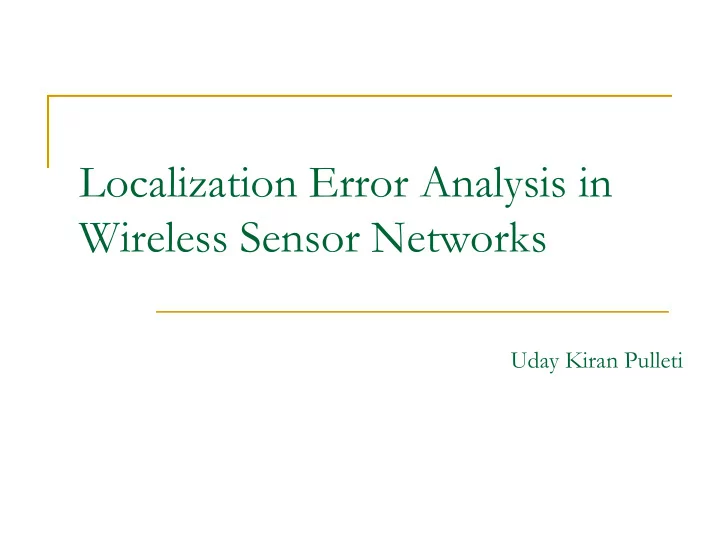

Localization Error Analysis in Wireless Sensor Networks Uday Kiran Pulleti
What is a Wireless Sensor Network ? � Entities Sensor Nodes • Beacon Nodes • Gateway Nodes • � Function Sample • Process • Communicate •
Wireless Sensor Networks � Why WSNs ? Small size, Low cost, High Reliability and Accessibility � Unique challenges Power, Random Deployment, Unreliable Communication � Applications Habitat monitoring, Battle fields, Surveillance, Nuclear power plants, etc. � Functions Parameter measurement, Target localization and tracking.
Localization � Node Localization � Source Localization � Differences Cooperative/Non-cooperative • Node Density • Computational Complexity •
Localization – A generic definition � Given a set of entities (nodes) with known locations and a source entity, the problem is to estimate the location of the source. � Location aware --- Sensor node � Location unaware --- Source
Localization � Measurements Modalities Received Signal Strength (RSS) • Time of Flight (TOF) • Time of Arrival (TOA) • Time Difference of Arrival (TDOA) • Direction of Arrival (DOA) • � Measurements Range • Range Difference •
Localization Algorithms � Mostly non iterative � Range Difference Locus is a hyperbola • At least four nodes are required • Least Square Estimation • � Range Locus is a circle • At least three nodes are required • Also Least Square Estimation •
Localization Error � Network Parameters Node density • Available energy resources • Circuit noise • Location errors • � Environmental Parameters Sensing modality and its propagation model • • Terrain’s geographical topology • Ambient noise levels
Problem Formulation � To characterize the localization error with respect to the network and environmental parameters in an algorithm independent manner
Notation ( x s , y s ) --- source location � --- estimated source location � � ( x i , y i ) --- i th sensor node � r i --- distance between the source and i th node � m i --- range measurement at the i th sensor node. � m ij --- range-difference measurement between i th and the j th sensor nodes
Error models � Range Measurements • Gaussian error
Error models � Range Difference Measurements • Joint Gaussian error
Error models � Range Difference Measurements • Derived Gaussian error
Data Collection Techniques � Closest N Activation Model (CNAM) � Fixed Radius Activation Model (FRAM)
Post-deployment and a priori error performance � Given sensor network � Random network (Poisson points) CNAM • FRAM •
Cramer-Rao Lower Bound
Cramer-Rao Lower Bound
Range Measurements – Post- deployment CRLB
Re-deployment stratagies � Constrained optimization
Range Measurements – A priori CRLB
CNAM
CNAM : K = 0
CRLB 3D plot for the nearest 6 nodes as a function of and
FRAM
Error Comparisons
Error Comparisons
Error Comparisons
Error Comparisons
Error Comparisons
Range Difference Measurements � Joint Gaussian model
Joint Gaussian model � CNAM � FRAM
Derived Gaussian model � CNAM � FRAM
Error Comparisons
Error Comparisons – Joint Gaussian Model
Error Comparisons – Derived Gaussian Model
Thank You
Recommend
More recommend